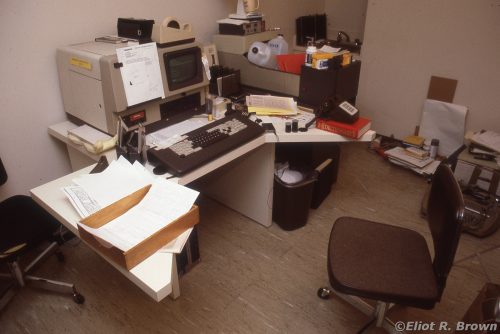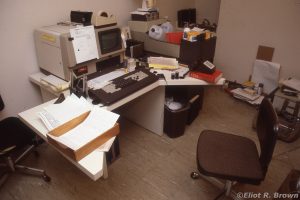Patient readers of this blog may have heard me refer to my typesetting computer.
Well, y’see… a long time ago we had a thing called “hot type.” Intriguing, no? It referred to precisely cast—in metal—typographic letters! Some time after those letters were carved out of wood and chiseled out of stone, those letter forms were taken from special trays of all of the letters and assembled by hand into broadsheets, flyers, books and newspapers. (These typesetting trays are used today to hold tiny bric-a-brac and hung from walls…) The letters and special bits and pieces of type and the surrounding spacing shapes were jammed into special rigs that would be placed on a printing press, add ink and some pressure—those letter forms would be banged off of paper! “Moveable type!”
The ’hot’ part of type reached apex when newspapers needed type set and fast. Hard to believe, the process involved a typewriter gadget, attached to a gigantic machine that translated the key strokes into stringing together molds of each letter. Molten lead was poured in and the rapidly cooled line-of-type would pop out ready to be put into one of those special rigs. This time for a newspaper page.
The transition from hot to cold was painful and contentious. The newspaper’s union typesetting guilds really didn’t want it to happen. But, to make a comic-ized analogy, computer coloring was inevitable.
And better. And cheaper. So cheap, even Marvel noticed.
The miracle of type that you could do in your own office was quite a while in coming. But for Marvel, it took place in 1982. There was a first “digital” typesetting computer, but you wouldn’t believe how it worked. To really appreciate it, I would have to draw diagrams. You still might not really believe it—such a wild contraption. But then Marvel got a Mergenthaller Linotype Print Maker and paid a low $15,000 if I remember correctly. Mergenthaller used to make the hot type monstrosities and were probably sighing in relief when cold type came to be.
‘Cold’ here means, simple black type on white paper. You do a little typing, press the ‘go’ button and remove the paper cassette from the machine, put the cassette in the light-tight chemical processor and bang, in as little as 3-4 minutes, cool, calm and collected—there’s your type.
There were several “tricks” here. There was a high-resolution CRT tube (just like a TV set, but about an inch across and able to resolve 2400 lines per inch) and a primitive digital computer. It ran on DOS. The machine was an inert piece of junk until you loaded in the “operating system” via a disk. Disk Operating System meant the whole shootin’ match of a program was on a 5.25” floppy disk.
And you had to load that program every time you turned the machine on. It forgot how to be a typesetting machine every power-down.
I kid you not. No “hard drive.”
This was an early computer. It had a green monochrome monitor that was a whole 9” across! No mouse. Only arrow buttons to move the cursor around. It also used a series of commands that would make font changes, from regular to bold or italic. But don’t forget to change it back—because you did not see a representation of that type style. In fact, you really had to pay attention. For one thing, the monitor displayed letters in a grid. Very simple. All the same size, from periods to the letter “M.” I used to quip, “Every letterspace counted.”
Strictly speaking, when copy or a manuscript came in, one was supposed to be a human typewriter. Simply taking what was before you and entering the info. What was not understood at the time was that it was also a word-processor. Which became so invaluable during the Official Handbook of the Marvel Universe, that the series would have been impossible to do without the machine. Or we would have had to wait several more years.
But I’ve made you wait a couple years already—
When we first moved from Madison Ave and 57th Street down to Park Avenue South and 27th—we had the machine on some kind of inappropriate table top. Uncomfortable to use after a short while. So designed the table you see above. I made such a fuss about the need for a comfy working table, my drawing made it to the architect who designed the offices and his shop built the one you see. His re-work of my idea was pretty fancy—double thickness plywood, supports for the cantilevered wings and finished in formica! It was nice. If you look, the cut out to image left was where the light-tight paper cassette fit.
In the picture, you can see the large black shape on top of the machine that was a paper cassette. To the right of the keyboard was a small FM radio that I listened to constantly (WNEW-FM). To the left of the keyboard is a set of regular shapes that the floppy disks that held everything.
The machine had two disk drives so you could copy disks one-to-the-other to make back-ups. No internal hard drive!
I had a cute little sink on the rear wall. Between the machine and the sink was the wet chemistry paper developer! The paper processor was an x-ray plate processor right out of a hospital. The paper was only 8” wide. During all my typesetter time, the plate processor never gave a lick of trouble.
On top of all the day-to-day work, this whole rig ran through all – ALL – the Marvel Universe work. Quietly, efficiently. Unlike myself and the redoubtable Brenda Ming (“Ming the Merciless”) – who took over as typesetter after I left around Book 12 (promoted to the Elysian Fields of Editorial and working for He Who Must Be Obeyed, Tom DeFalco… but that… is another story!)

